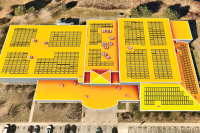Developers haven’t earned a break from the rules
They didn’t show up. That alone signals, or maybe “symbolizes” is the proper word, a shift in citizen attitudes that would have seemed unimaginable just a couple of years ago.
The “they” in this case are the Wal-Mart-hating, big-box loathing hard-liners who love the charm of small-town living and believe that mega-stores like Wal-Mart and Home Depot destroy small businesses and a uniquely American way of life. The protesters are all over the country, organizing regular rallies against a company that has become so big and brazen it has spawned a cottage industry of enemies who like to use phrases like “merchants of shame” and start movements like the recent “quarantine Wal-Mart” campaign.
But none of this crowd showed up at a hearing two weeks ago at Waynesville Town Hall. The meeting was to listen to preliminary plans for the re-development of the old Dayco rubber factory site in West Waynesville into a big-box center that is expected to start out with a Super Wal-Mart, a Home Depot and a Staples.
Is the fight over?
The news still filters over the Internet and into newspapers about communities that have successfully kept Wal-Marts out, but for the most part it’s a long, tough fight that almost always ends up as a losing cause. Wal-Mart is, after all, the world’s most powerful company. They’ve taken the fight out of most communities.
The rage against the corporation has shifted into a new arena. At first it was standing up for the small businesses, those independently owned stores that discount operations like Wal-Mart slowly drive out of business. Now, the fight has moved to a different front. Many argue that Wal-Mart should be broken up and treated like the industrial leviathans of the past, like Standard Oils and the Ma Bell. The philosophy behind breaking up huge monopolies is that they held so much control over the markets that they would eventually raise prices and gouge the consumer.
Related Items
Wal-Mart’s business model, however, doesn’t work like that. It controls enough of the market that it is able to set the price it will pay to its producers, thereby keeping consumer prices low. It is joined by a long list of other huge retailers now practicing this model, and by doing so they have managed to rein in any kind of global vigor for breaking up the monopoly.
It doesn’t matter that we don’t yet know what the long-term effects on communities of this one-stop shopping store will be. As it is, Wal-Mart is where you get what you need; every place else is where you get what you want, the luxuries.
As we’ve tacitly thrown in the towel on the idea of breaking up monopolies, let us at least look back a little before we give in completely. There was a simple, pure argument for not letting huge businesses monopolize too much of the marketplace. In U.S. vs. Alcoa in 1945, Judge Learned Hand wrote: “the organization of industry in small units that can effectively compete against each other” is the goal of anti-trust laws. In this model, prices are low, profits are high, and workers are paid more.
It’s that last part of the equation that is missing. The workers at Wal-Mart aren’t being paid more. I don’t pretend to be an economist, but something is wrong if we think it’s OK that free market capitalism has produced a society where both parents in middle- and low-income families must work all the time just to scrape by and therefore feel they must have Wal-Marts in order to buy cheap goods.
The kicker
At the recent public hearing in Waynesville, the crowd was criticizing the developer’s plan for signs, trees, the parking lot, the building’s façade and the look of the shopping center. In other words, people want it to look more like downtown, more pedestrian-friendly.
That desire, though, creates a whole new set of conundrums. If we start making Wal-Marts look like quaint downtown shopping districts, then what happens to the real quaint downtown shopping districts? Will consumers be lulled, over time, into thinking big boxes that look nice are good for their towns?
This sounds like a real battle, with the two ends of Main Street squaring off like two boxers in the ring: In this corner, from the heart of downtown, the independent bloc of galleries, shops and restaurants who have come into this fight after nearly two decades of taking on strip centers and big boxes. But this one’s different folks. In the other corner this time, from across the tracks on the west side, a giant big box development that never loses no matter what is thrown at it. Big, tough and unyielding. Yes, this should be a classic fight.
In truth
The reality, though, is that this battle has already been fought. It’s been proven that downtowns like Sylva and Waynesville, Bryson City and Franklin can survive and even thrive against the big-box competition. But it takes a unique community and governmental support.
It’s why organizations like the Downtown Waynesville Association and the Downtown Sylva Association are so important. When Sylva leaders a few weeks ago yanked financial support for DSA and cited a long list of reasons for why downtown will succeed without their help, they left out a very important consideration — in the old days there weren’t Wal-Marts and Lowes and Home Depots lurking on the edge of town trying to gobble up the mom and pops. The success of the suburban retail centers forced communities to re-think their downtowns, and that’s when downtown merchant groups — who often depend on the town tax base for help — came into vogue.
It’s why organizations like chambers of commerce are so important. These organizations take to heart their mission of looking out for the small businessman. They encourage entrepreneurship and community-driven campaigns to get people to shop with their neighbors.
On the national front, groups will form to challenge the Wal-Marts of the world and make them pay better salaries, treat their employees better and perhaps even shame them into buying some of their goods from American factories (instead of building new stores on top of the ghosts of American manufacturing’s past). What we can do at the local level is insist that these developers abide by the ordinances and laws we have, including the strictest of land-use regulations. They don’t deserve any breaks, not a one.
And after it’s all said and done, and the new signs and buildings and roads are built and the cash registers are ringing, we can’t forget the guy down the block trying to sell shovels or sneakers or whatever. Those are the people who never expected anyone to give them anything, and instead were always giving back. That’s the model these newcomers need to follow.
(Scott McLeod can be reached at This email address is being protected from spambots. You need JavaScript enabled to view it..)









